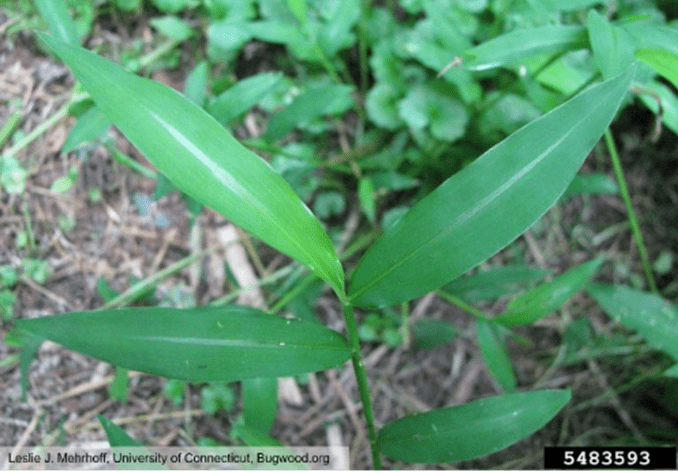Kelly Nichols, Agriculture Agent | kellyn@umd.edu
University of Maryland Extension, Montgomery County
Japanese stiltgrass is an invasive grass that is typically seen in wooded areas. It likes shaded, wet areas and can easily take over the forest understory. Unfortunately, it can also creep into pastures and hay fields. The leaves of Japanese stiltgrass are wider and shorter than most of our common pasture grasses. There is also a distinctive silvery midvein that is slightly off-center from the middle of the leaf (Figure 1). Japanese stiltgrass also has a shallow root system, so it can be pulled out easily. For more information on how to identify stiltgrass, visit USDA’s National Invasive Species Information Center website.

The one (and only one) positive thing about this invasive is that it is an annual, so there’s no perennial root system to contend with. However, as an annual, stiltgrass spreads by seeds. Seedheads start to form in mid-September through October. Once they are visible but before they produce hard seed (Figure 2), mow the area to prevent the seeds from maturing and becoming viable. Stiltgrass will likely not have enough time to regrow and set more seeds before the first frost.

Herbicides are another option. A broad spectrum herbicide such as glyphosate, can be used to control stiltgrass; however, keep in mind that broad spectrum herbicides will injure or kill any plant that it touches. So, this would be an option for spot-spraying heavily infested areas.
Prowl H2O®, which contains the active ingredient pendimethalin, is labeled for applications on established grass that has at least 6 tillers. Prowl H2O is a pre-emergent herbicide, and must be applied before the stiltgrass emerges in order to suppress germination. Stiltgrass can germinate as early as when the soil temperature is about 50 °F, so Prowl H2O will need to be applied earlier than when we may be used to when controlling other summer annual weeds. While Prowl H2O is a good option, re-seeding restrictions of 10 months for pasture grasses and 6 months for alfalfa may make it a challenge for reseeding after the stiltgrass is gone. (Remember, Prowl H2O is a pre-emergent herbicide, so it will prevent grass and alfalfa seeds from germinating, too.) If Prowl H2O is used, manage the bare areas so that weeds cannot take over before re-seeding can be done.
Once a control method is implemented, re-seed bare areas so they are not left for stiltgrass and other weeds to fill back in. Following your nutrient management plan can also be helpful to provide the hay and pasture grasses the fertility they need to compete with the stiltgrass.
